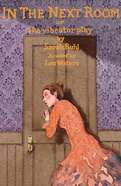Behind the Buzz with Vibrator Playwright Sarah Ruhl
About the author:
Based on the subject matter, playwright Sarah Ruhl’s Broadway debut, In the Next Room or the Vibrator Play, could be expected to have a tawdry, downright pornographic backstory. But as Ruhl, a Pulitzer Prize finalist for 2005’s The Clean House and recipient of the MacArthur Fellowship, explains, the play’s inspirational spark has utterly innocent origins—even if some shocking revelations came out of her research. At Broadway.com’s request, the scribe behind such thought-provoking off-Broadway successes as Eurydice and Dead Man’s Cell Phone breaks down the starting point of her surprisingly sweet, intimate new play, giving us some insight into why the piece is more about love and marriage than sex toys.![]()
I have always wanted to write a costume drama. With corsets, bustles and gloves. After spending a good part of my youth reading Jane Austen and Charlotte Bronte sick in bed while the other kids in my alley were playing Ghost in the Graveyard, I’ve always had a strange affinity for the 19th century. But I’ve also always been fascinated by what 19th-century novels pointedly left out: No one has sex, no one goes to the bathroom and, certainly, no one uses a vibrator. I was amazed to find, after reading Rachel Maines’ revelatory book, The Technology of Orgasm, that many women (and a few men) were treated with electric vibratory massage to ameliorate the symptoms of hysteria. What perhaps stunned me even more was that gynecologists and psychiatrists had used the “manual treatment” before this remarkable new invention came out, at the dawn of electricity.
The play In the Next Room takes this historical fact as a leaping-off point—that many women (and a few men) were treated for hysteria with vibrators at the turn of the century—and moves into other terrain, as we follow the story of an enterprising and well-meaning doctor who treats hysterical women, his wife (who is terribly curious about the treatment), his patients and the wet-nurse who cares for the couple’s new baby. Though the vibrator may have been the play’s starting point, ultimately I’m more interested in the relationships that expand around the device, and the whole notion of compartmentalization, of what goes on “in the next room”—literally, in the room next to the living room where the vibrations take place, but also in the next room of other people’s minds and bodies. To what extent does marriage imply a “next room?” Or relations between employers and employees—particularly the very intimate and difficult relationship of a mother and her wet-nurse, who, tragically, lost her own child and is now nursing another’s? To what extent was there a mind/body split in the 19th century?
And are we now really any better off? Now that pornography has gone mainstream, are our bodies and minds any more integrated, in any more radically intimate way? The emotional and bodily restraint that so inhibited our forbears, and that we shrugged off in the last century, is now perhaps somewhat desirable, in the age of no privacy. Perhaps restraint will be the new daring mode, now that so many sexual barriers have been broken down. Having become numb to billboards in which everything from jeans to pharmaceutical drugs are sold with sex, I sometimes long for a time when an ankle was breathtaking, or the touch of a hand across a teapot. But isn’t it still true that the shared look, the glance across the lit room, is sometimes a more terrifying and thrilling intimacy than anything that goes on in the dark? (Depending on who the company is…)
People coming to the play expecting a sexual spectacle appropriate to the old Times Square might be either disappointed or relieved, depending on their predilections. As the 19th century doctors were discreet, so are we—and much of the action happens under a clean white sheet. In that sense, the play is very innocent. As I wrote the play and immersed myself in 19th century personages, I was interested in their radical or willful innocence about sexuality. Innocence on the part of both the doctors and the patients.
Vibrators were advertised alongside electric kettles and irons in publications like The Ladies Home Journal. Henry James himself was said to have gotten the treatment; one vibrator designed specially for men was called the Chattanooga. The shudder that was produced by the vibrator was called a paroxysm, not an orgasm. Whereas the Greeks and the Chinese and even the Elizabethans seemed to know a great deal about how to give women orgasms, after Queen Victoria took the throne, there appeared to be a collective cultural amnesia about such things for a hundred years. In the privacy of their own bedrooms, couples may have been even more inventive than we are today, without being inundated by images of what sexuality was supposed to have been. But other couples seem to have lived under a dark shroud of silence.
Ultimately it is the silence between people, and how they manage to shatter it, that draws me to these characters. And I think as sophisticated as we moderns are, we certainly understand silence between people—and the comedy (or tragedy) that results when two people in adjacent rooms are unable or unwilling to speak.
